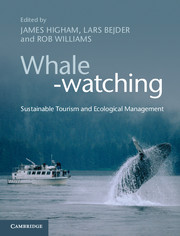Book contents
- Frontmatter
- Dedication
- Contents
- Acknowledgements
- List of contributors
- List of abbreviations
- 1 Tourism, cetaceans and sustainable development
- Part I The historical and contemporary contexts
- 2 Threats facing cetacean populations
- 3 From exploitation to adoration
- 4 Human attitudes and values
- 5 The whale-watching industry
- 6 The International Whaling Commission (IWC) and whale-watching
- Part II Human dimensions of whale-watching
- Part III Ecological dimensions of whale-watching
- Part IV Sustainable management: insights and issues
- Index
- Plate Section
- References
5 - The whale-watching industry
Historical development
from Part I - The historical and contemporary contexts
Published online by Cambridge University Press: 05 April 2014
- Frontmatter
- Dedication
- Contents
- Acknowledgements
- List of contributors
- List of abbreviations
- 1 Tourism, cetaceans and sustainable development
- Part I The historical and contemporary contexts
- 2 Threats facing cetacean populations
- 3 From exploitation to adoration
- 4 Human attitudes and values
- 5 The whale-watching industry
- 6 The International Whaling Commission (IWC) and whale-watching
- Part II Human dimensions of whale-watching
- Part III Ecological dimensions of whale-watching
- Part IV Sustainable management: insights and issues
- Index
- Plate Section
- References
Summary
Introduction
The story of commercial whale-watching spans half a century from the first $1 USD earned on the back of a grey whale (Eschrichtius robustus) in 1955 to the $2.1 billion USD industry of today (Hoyt, 2009a; O’Connor et al., 2009). As with many new entertainment ‘industries’ of our era ranging from surfing to the iPods, iPhones and iPads of Apple Computer, Inc., it all started in California. The surprise perhaps lies in how popular and pervasive worldwide the whale-watching industry has become – to the extent that we now focus on the implications from ‘too much success’, try to limit the industry in some areas, and ask if true sustainability is achievable.
The origins and early historical development of the whale-watching industry have shaped the industry to this day. Considering the developmental stages of tourism and rate of growth experienced by the whale-watch industry helps us understand its impact. Whale-watching has been profoundly influenced by a number of factors: (1) the platform used, including the types of boats, as well as the background and location of the whale-watching owner-operators; (2) the species being watched and the peculiar geography of the ecosystem where they are found; and (3) the typology of the visitors or tourists taking the trips and their expectations. Looking at all these aspects helps us grasp what the industry has become today and the implications for the future.
- Type
- Chapter
- Information
- Whale-watchingSustainable Tourism and Ecological Management, pp. 57 - 70Publisher: Cambridge University PressPrint publication year: 2014
References
- 27
- Cited by

